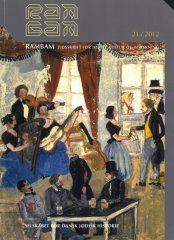Formidlende fortællinger - M.A. Goldschmidts forfatterskab
Resumé
Tales that convey - the writings of M.A. Goldschmidt
The Jewish tales that author and journalist Meïr Aron Goldschmidt wrote during the second half of the nineteenth century describe the religious development and emancipation of the Jews of Western Europe throughout the century. This article shows how Goldschmidt’s travels in Europe provided him with a cosmopolitan view on the religious development of the Jews and stresses the importance of his Jewish stories, not only in national but also in international means.
When Goldschmidt first travelled abroad in 1846, he visited Germany, Italy and Switzerland and during his visits he gained a broader religious and political view on the Jewish emancipation. He brought home with him a new understanding of his religion and a political vision, which he communicated in his Jewish stories.
Many of Goldschmidt’s viewpoints were similar to those of the Jewish philosopher Moses Mendelssohn, who expressed his viewpoints after his religion was challenged by philosopher and writer Gotthold Ephraim Lessing in the eighteenth century. Mendelssohn emphasised the Jewish laws and traditions and did not believe that integrating with the Christian people necessarily equalled a decrease of the Jewish faith. Goldschmidt shared Mendelssohn’s thoughts on the development of the Jewish religion, and he feared that the Jewish emancipation would lead to assimilation of the Jews.
In his first novel, The Jew of Denmark, Goldschmidt expresses a criticism of the ambiguous politics behind the emancipation that he felt announced religious tolerance when really wishing for the Jews to convert to Christianity. He also criticises the Jewish reformers for wanting education and integration at the expense of their religion. Goldschmidt was a strong advocate of enlightenment and education like the Jewish reformers, but he did not want to compromise his religious beliefs.
In his novel, The Raven, he conveys his political vision – a vision that unites his view on religion with the nation. To Goldschmidt, religion was a personal matter that no government should interfere with. In The Raven he implicitly shows how people can put their differences in religion, class and profession aside and agree on a common idea. Goldschmidt ended his literary career with a series of Jewish ghetto-stories that praise the Jewish religion but at the same time show that the meaning of the religion has changed and that the orthodox Jew is a diminishing kind.
Goldschmidt’s Jewish stories are international literature that provides a personal insight into the Jewish emancipation of the Western European Jews in the nineteenth century.





